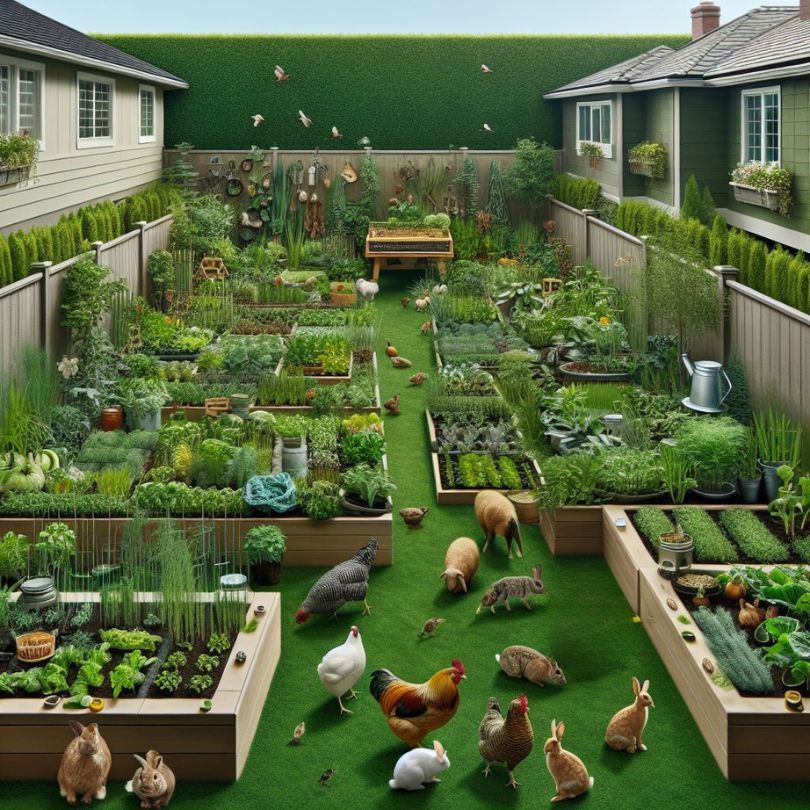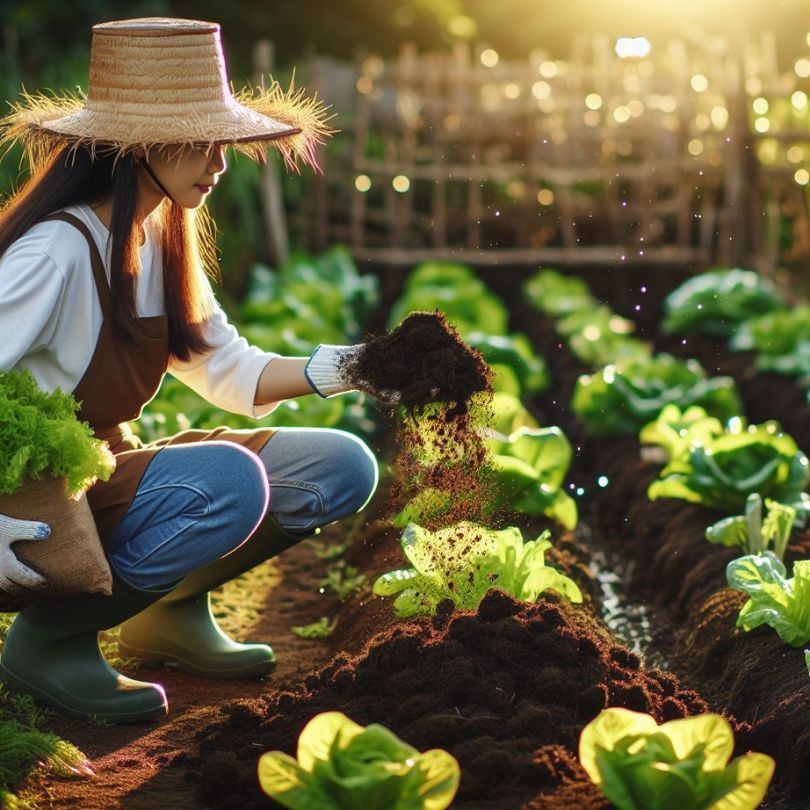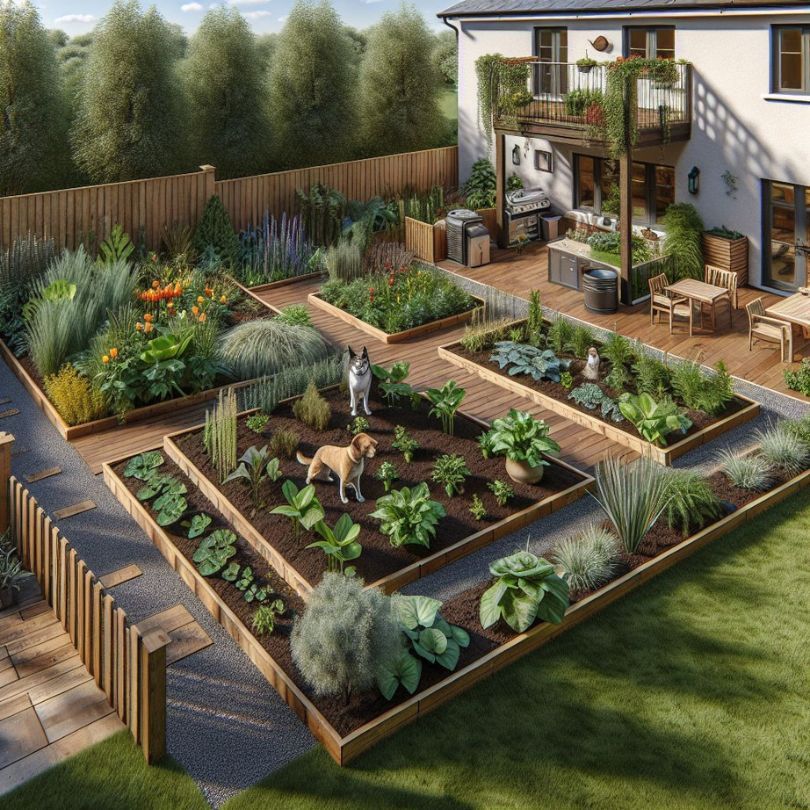
Key Takeaways
Integrating animals into your survival garden enhances soil fertility and pest control.
Selecting appropriate animals, such as poultry or small livestock, depends on your garden’s size and your self-reliance goals.
Manure from animals like chickens and rabbits can be composted to enrich garden soil.
Designing a pet-friendly garden involves choosing non-toxic plants and creating safe zones.
Training pets and setting boundaries can prevent damage to your garden while still benefiting from their presence.
The Core Foundations of a Survival Garden
When you think about a survival garden, what comes to mind? Maybe rows of vegetables or a patch of herbs. But there’s more to it than just plants. A thriving survival garden works in harmony with nature, and that includes animals. Let’s talk about how integrating animals can transform your garden into a self-sustaining ecosystem.
The Importance of Diversity in Crops and Livestock
Diversity is key in a survival garden. Just like a financial portfolio, you don’t want to put all your eggs in one basket. Planting a variety of crops ensures that if one fails due to pests or disease, you won’t lose your entire food source. But what about animals? They play a crucial role too. Chickens, ducks, and even bees can pollinate plants, control pests, and fertilize the soil. It’s a win-win situation.
Maintaining Soil Fertility with Animal Integration
Soil fertility isn’t just about what you add to it; it’s about what lives in it. By integrating animals into your garden, you’re bringing in natural fertilizers—manure. It’s full of nutrients plants crave. But remember, it’s not as simple as letting animals roam free. There’s a method to the madness, and I’ll show you how to do it right.
Selecting the Right Animals for Your Garden
Not all animals are suited for every garden. You’ve got to consider the size of your space, the time you can dedicate, and what you want to achieve. Let’s dive into which animals might be the best fit for your survival garden.
Small Versus Large Animal Considerations
If you’re working with limited space, think small. Rabbits and chickens don’t need much room and can provide you with meat, eggs, and manure. On the flip side, if you’ve got more land, you might consider larger animals like goats. They can clear land and provide milk. But they also require more care and stronger fences.
Benefits of Poultry: Chickens and Ducks
Poultry, such as chickens and ducks, are a great starting point for integrating animals into your garden. Chickens scratch the earth and aerate the soil, while ducks will happily forage for slugs and snails. Both provide eggs and their manure can be composted to create a nutrient-rich amendment for your soil.
Rabbits and Goats: Compact Livestock for Efficiency
Rabbits are another excellent choice for small spaces. Their manure can go directly onto garden beds without composting, as it won’t burn plants. Goats require a bit more room and infrastructure, like sturdy fencing, but they’re efficient at converting weeds and scraps into milk and manure.
Utilizing Manure as Compost for Plant Health

One of the best ways to boost your garden’s health is by utilizing manure as compost. Manure from chickens, rabbits, and goats is rich in nitrogen, phosphorus, and potassium—essential nutrients for plant growth. But it’s not just about dumping it onto your plants; there’s a proper way to compost it to prevent burning your plants or introducing pathogens.
Start by setting aside a space for composting away from your main garden. Layer the manure with brown materials like dry leaves or straw, and green materials like kitchen scraps or grass clippings. This mix will decompose over time, breaking down into a dark, crumbly substance that’s perfect for adding to your garden beds.
Natural Pest Control Through Animal Grazing Patterns
Animals can be your allies in keeping pests at bay. Chickens and ducks, for instance, love to snack on common garden pests like aphids, caterpillars, and grubs. By allowing them to forage in the garden at specific times, they can help control pest populations naturally. This means less reliance on chemical pesticides and a healthier ecosystem for your garden.
However, timing is everything. You’ll want to let your poultry graze after the harvest or before planting new crops to prevent them from damaging your plants. It’s all about creating a balance where your animals can fulfill their natural behaviors while also contributing to the garden’s health.
Designing a Pet-Friendly Garden
Now, for those of us with pets, it’s important to create a garden space that’s safe for them too. Dogs and cats are curious by nature, and without the right precautions, they can trample plants or even get sick from toxic foliage. Designing a pet-friendly garden takes some planning, but it’s well worth the effort for the peace of mind it brings.
Choosing Non-Toxic Plants to Ensure Pet Safety
First things first, choose plants that are non-toxic to your pets. Many common garden plants can be harmful if ingested, so do your research before planting. For example, tomatoes and onions are no-gos for dogs, while lilies can be deadly to cats. Stick to pet-safe options like carrots, blueberries, and sunflowers to keep your furry friends out of harm’s way.
It’s also a good idea to have a dedicated area for your pets to enjoy that’s separate from your vegetable beds. This can be a grassy area where they can play without the risk of running through your carefully tended plants.
Creating Safe Zones and Boundaries within Your Garden
Creating clear boundaries is crucial. Use fences or raised beds to delineate where pets can and cannot go. If you have a dog, consider training them to understand the limits of the garden space. This not only protects your plants but also keeps your pet from ingesting something that could be harmful to them.
For smaller pets like rabbits or chickens, having a movable enclosure or “tractor” allows them to graze and fertilize different areas without permanently damaging the garden. This way, they can enjoy fresh grass and you can rest easy knowing your plants are safe.
Prepper Pet Tips: Making Pets an Asset
Your pets can be more than just companions; they can be a vital part of your survival strategy. With the right training and setup, pets can contribute to your garden’s success and overall self-reliance. Let’s look at how to make your pets an asset to your survival garden.
For starters, dogs can be trained to keep away common garden pests like deer or rabbits. Their presence alone can be a deterrent, but with specific training, they can actively patrol the garden and protect it. Cats, on the other hand, are natural hunters and can help control rodent populations.
Even smaller pets like guinea pigs can contribute by providing manure. Their waste is rich in nutrients and can be added to your compost pile. Just remember to balance it with other compost materials to avoid any potential issues.
Train dogs to patrol the garden and deter pests.
Use cats’ natural hunting instincts to control rodents.
Compost guinea pig manure for a nutrient boost.
Training Your Pets to Coexist with Your Garden
Training is essential. Start by introducing your pets to the garden area and teaching them the boundaries. Use positive reinforcement to encourage them to stay within designated zones. For dogs, this could be treats for staying out of the garden beds, and for cats, a scratching post or catnip planted in safe areas to attract them away from your vegetables.
It’s also helpful to provide a space for pets to fulfill their needs, like a sandbox for cats to use instead of your garden beds or a shaded area for dogs to rest. This keeps them happy and prevents them from seeing your garden as a playground.
Protective Roles Pets Can Play in Garden Management
Pets can also play protective roles in your garden. Besides pest control, dogs can act as a warning system for larger threats, like trespassers or wild animals. Their keen senses can alert you to issues before they become problems. With proper training, they can be an invaluable part of your garden’s defense system.
Common Challenges and Solutions in Garden and Animal Integration

Integrating animals into your survival garden isn’t without its challenges. Digging, grazing, and natural animal behaviors can sometimes clash with your gardening goals. But fear not, there are solutions to these common issues.
Addressing Digging and Grazing Issues
Digging can be a real headache, especially if you have dogs or chickens. One solution is to provide a dedicated digging area for your pets. For chickens, a dust bath area can satisfy their need to dig and bathe, keeping them away from your plants. For dogs, a small sandbox or a designated digging spot with buried toys can work wonders.
Grazing can also be managed with proper fencing and supervision. If you have goats, make sure they have enough forage or hay to keep them satisfied and away from your precious plants. Rotational grazing can also help manage their impact on the land.
Seasonal Considerations for Garden and Animal Health
Seasons change, and so should your approach to garden and animal integration. In spring, it’s all about planting and birthing. Make sure your garden beds are prepared for new growth and your animals have the resources they need for reproduction. Summer is about maintenance—keeping pests at bay and ensuring your animals have shade and water. Come fall, it’s harvest time, and you’ll need to start preparing your animals for the colder months. Winter is the time for rest, both for the garden and your animals, but it’s also a good time to plan for the next year.
Most importantly, always ensure your animals have access to clean water, no matter the season. A thirsty animal is a stressed animal, and stress can lead to health issues and lower productivity.
Spring: Prepare garden beds and ensure animals have resources for reproduction.
Summer: Maintain pest control and provide animals with shade and water.
Fall: Harvest crops and prepare animals for winter.
Winter: Rest and plan for the upcoming year.
Because animals can be sensitive to extreme temperatures, provide insulated shelters in winter and cool, shaded areas in summer. This helps prevent stress and keeps your animals healthy, which in turn keeps your garden healthy.
FAQ
Now, let’s tackle some frequently asked questions about survival garden animal integration. These are real concerns from folks like you, looking to create a harmonious and productive garden ecosystem.
How do you protect a survival garden from free-range chickens?
To protect your survival garden from free-range chickens, consider using portable chicken fencing to create a barrier. You can also plant chicken-resistant plants like lavender and rosemary around the perimeter of your garden. Another tip is to provide a dedicated area for your chickens to scratch and peck away from your precious crops.
What are the best small animals to start with for new homesteaders?
For new homesteaders, chickens are often the best small animals to start with. They’re relatively low-maintenance, provide eggs, and can help with pest control. Rabbits are another great option, as they reproduce quickly and their manure is excellent for the garden. Both are small enough to manage easily and can be a great introduction to animal integration.
Here’s a quick comparison: for those interested in enhancing backyard garden biodiversity and resilience.
Animal | Benefits | Considerations |
|---|---|---|
Chickens | Eggs, pest control, manure | Need protection from predators, require daily egg collection |
Rabbits | Quick reproduction, manure | Need secure housing, breed control is necessary |
How can pets contribute to a survival garden’s ecosystem?
Pets contribute to a survival garden’s ecosystem in many ways. Dogs can deter larger pests and protect the garden, while cats can keep rodent populations in check. Even smaller pets like guinea pigs can contribute by providing nutrient-rich manure for composting.
Here’s a real-world example: integrating animals into your survival garden can provide numerous benefits, but it’s important to do so safely to protect both the garden and the animals.
A family I know integrated their dog into the garden by training it to patrol the perimeter. Not only did the dog enjoy the responsibility, but it also kept deer and other critters at bay, reducing the need for fencing and other deterrents.
Besides that, the companionship of pets can be a morale booster during the hard work of tending to a survival garden.
What should be considered when introducing new animals to an existing garden?
When introducing new animals to an existing garden, consider their impact on the current ecosystem. Introduce them slowly to avoid stress, and monitor their interactions with existing animals and plants. Ensure they have adequate shelter, food, and water, and that their presence won’t negatively affect your garden’s productivity. For more in-depth guidance, check out our article on enhancing backyard garden biodiversity and resilience.
Can a survival garden provide enough food for my animals during the winter?
A survival garden can provide enough food for your animals during the winter if you plan accordingly. Growing winter-hardy crops like kale and turnips can extend your growing season. You can also preserve excess summer produce through canning or drying to supplement your animals’ diets in the colder months.
Remember, it’s also about balance. You’ll need to calculate how much food your animals will require and compare it to your garden’s output. Sometimes, you may need to supplement with additional feed.







Leave a Reply